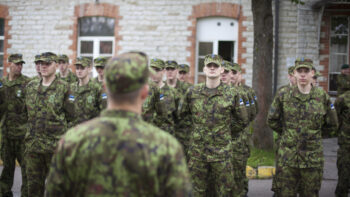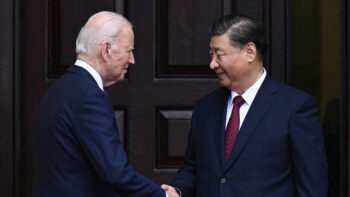
U.S. Marines with Marine Aviation Logistics Squadron 31 and Marine Aerial Refueler Transport Squadron 252 refuel and arm two F-35Bs assigned to Marine Fighter Attack Training Squadron 501 at Marine Corps Auxiliary Landing Field Bogue, North Carolina, Nov. 18, 2021. (US Marine Corps/Chief Warrant Officer Bryan Nygaard)
WASHINGTON: Air Force Lt. Gen. Michael Schmidt took the reins of the Pentagon’s F-35 program office today, where he will lead the continued development of the Defense Department’s most notorious and expensive weapons program.
Schmidt — formerly the Air Force’s program executive officer for command, control, communication, intelligence, and networks (C3I) — replaced Air Force Lt. Gen. Eric Fick, who led the F-35 Joint Program Office since July 2019.
Schmidt takes over the F-35 program office as contract negotiations for F-35 Lots 15-17 continue to drag on despite more than a year of discussions. Fick told reporters in March that the Pentagon and F-35 maker Lockheed Martin had yet to come to agreement on the unit cost of the aircraft, though they will likely be higher than the previous batch due to supply chain issues.
Schmidt will also oversee the F-35 as it moves through its Block 4 modernization program, where the baseline jet is upgraded with additional weapons, as well as improved sensors, mission systems and software.
“I’m truly honored to have been asked to take over the best fighter aircraft in the world and look forward to make it even better,” Schmidt said during the change of command ceremony.
Leadership of the F-35 JPO has typically followed a set pattern, with the Air Force and Navy alternating control of the program office and the top job moving from the program executive to the deputy. However, Schmidt bucks both of those trends, as he comes from outside the F-35 program office and follows a fellow Air Force officer.
Schmidt’s resume includes extensive experience overseeing complicated weapons systems. He most recently oversaw the Air Force’s $15 billion C3I portfolio, a diverse enterprise that includes cyberspace capabilities, electronic warfare systems and software development factories, among others. Before that, he led the service’s fighters and bombers program office from 2016 to 2018, and from 2003 to 2005 he worked as the Pentagon’s F-35 lead program element monitor when the Joint Strike Fighter was in its early stages of development.
When Fick took over the F-35 program office in 2019, he expected to oversee production of the jet as it ramped up to full-rate, he said during today’s ceremony. That took a turn when Turkey was booted out of the program in 2019, leaving the JPO to eliminate Turkish companies from its supply chain, and further was complicated by the COVID-19 pandemic, which set back the planned increase in production.
“The team responded magnificently, delivering hundreds of aircraft despite that global pandemic, delivering hundreds of engines despite the global pandemic, delivering software on time despite the global pandemic,” Fick said, adding that the pandemic forced him to delegate greater power to lower-level officials.
“My priorities over the course of these last years have evolved into ‘people first,’” he said. “Because I know that at the end of the day, we’re going to have other challenges. There will be COVID part two or three or six.”
Taking aim: Army leaders ponder mix of precision munitions vs conventional
Three four-star US Army generals this week weighed in with their opinions about finding the right balance between conventional and high-tech munitions – but the answers aren’t easy.


























